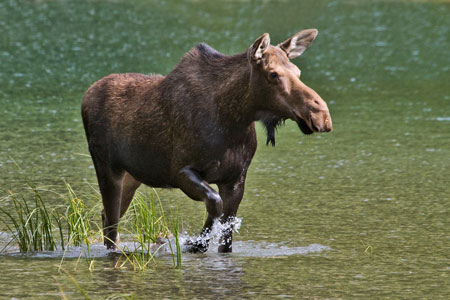

|
Moose (Alces alces) 
Description: Moose are the largest members of the deer family and one of the largest land mammals in North America. Adults may stand as tall as 2.3 m high. Their massive bodies are covered with short dark brown fur. They have large ears and a long square face. A flap of skin known as a bell sways beneath the moose's throat. Males possess elaborate, widened antlers that can measure up to 2 meters in width, from tip to tip. Moose shed their antlers in the fall and early winter following the end of the breeding season. Every year male moose grow a new set of antlers that is generally larger than the previous year's "rack." Females do not grow antlers and are smaller than the males. Mass: 270 to 600 kg; avg. 435 kg (594 to 1320 lbs; avg. 957 lbs) Length: 2.40 to 3.20 m (7.87 to 10.5 ft)
Moose, in Washington, are mostly limited to the northeast corner and the northeast Cascades, but are expanding their range and numbers. A few show up occasionally near Bellingham on the west side. In the Northeast Cascades, they are found along major water courses, primarily in Okanogan County. They can be found in coniferous and hardwood, closed canopy forest near stream bottoms, lakes and other wet areas. Click the range map to learn more about the distribution of Moose in Washington. Diet: Moose are herbivores. They eat twigs, bark, roots and the shoots of woody plants. They especially prefer willows and aspens. In the warm months, moose feed on water plants, water lilies, pondweed, horsetails, and bladderworts. In winter, moose browse on conifers (evergreen trees) including the needle-like leaves of balsam fir. 
Behavior: Moose are active throughout the day with activity peaks during dawn and dusk. Moose are good swimmers and can be found in and around streams. They move swiftly on land - running at speeds up to 35 miles per hour. They are able to trot steadily at 20 miles per hour (which is faster than the average man can run). Moose are solitary animals and move independently. Two or more individuals sometimes can be found feeding along the same stream. The mother and the calf form a strong social bond. Reproduction: Bull Males bellow loudly to attract mates each September and October. The bulls are normally solitary (live alone), but come together during the mating season to battle with other males using their huge antlers. The victorious male gets to mate with the female. Female moose give birth to one or two calves in the spring. Calves weigh about 14 kilograms (30 pounds) at birth. It has be reported that the young calves are fast and can outrun a person by the time they are only five days old. The young hang out with the mother and grow quickly over the first year. They become independent of the mother by the following mating season.
Did you know?

Moose (male) with antlers that can measure over 1.8 meters (6 feet) wide. More information: Alces americanus Information - Animal Diversity Web Why it's best to leave antlers on the ground - National Park Service Antler & Horn Match Games - National Park Service More photos: Moose Photos |
Animal silhouettes available to purchase »
Photos: Natures Pics
Home | About Us | How to Participate | Biodiversity Modules | Projects | Maps | News | Resources